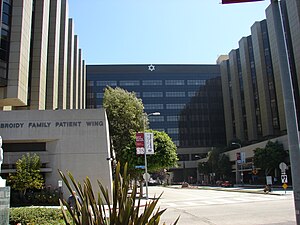Cedars-Sinai Medical Center
| Cedars-Sinai Medical Center | |
|---|---|
| place | los Angeles |
| Country | United States |
| Coordinates | 34 ° 4 ′ 31 ″ N , 118 ° 22 ′ 50 ″ W |
| Care level | Specialized hospital , perinatal center |
| beds | 958 |
| Employee | 12000 |
| including doctors | 2000 |
| founding | 1902 |
| Website | www.cedars-sinai.edu |
The Cedars-Sinai Medical Center ( ) is a non-profit - Hospital in Los Angeles , USA .
History and focus
It was founded in 1902 under the name Kaspare Cohn Hospital . It is a multidisciplinary academic center and part of the Cedars Sinai Health System .
The Cedars-Sinai Medical Center serves as a teaching hospital, among other things for the David Geffen School of UCLA and the University of Southern California .
The staff body consists of approximately 2,000 physicians and 10,000 other employees and supervised stationary up to 958 patients .
Known employees
- Harold Jeremy Swan developed the Swan-Ganz catheter together with William Ganz in 1970 .
- David Ho was a resident at Cedars when he first encountered reports of AIDS. Since then he has been working in AIDS research. He was one of the first scientists to realize that AIDS is caused by a virus.
- Keith Black is a neurologist .
- Helen Landgarten worked as an art psychotherapist in the psychiatric department at Cedars-Sinai Medical Center.
- Myron Prinzmetal worked in the laboratory.
- Irving L. Lichtenstein developed a surgical technique named after him that fundamentally improved the treatment of hernias , and for this reason is considered a pioneer in hernia surgery.
- Franz Daschner was an Infectious Disease Fellow at the Cedars Sinai Medical Center.
- John Hans Menkes was a neurologist and head of pediatric neurology and is considered to be the discoverer of Menkes disease .
Web links
Commons : Cedars-Sinai Medical Center - Collection of pictures, videos, and audio files
- Official website (English)
